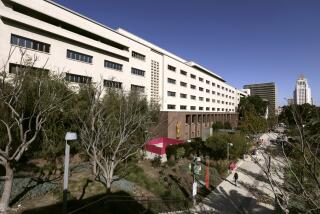New Police Headquarters Site Draws Ire
- Share via
Two months after it appeared the Los Angeles City Council had ended years of wrangling over where to put a new police headquarters, the issue is once again generating opposition from potential neighbors.
Downtown residents angry over the council’s last-minute decision in June to put the new headquarters on land they maintain was intended for a park will take their protests to City Hall tonight, where Councilwoman Jan Perry will unveil early models of the new headquarters.
“We fully understand the need for a new police facility,” said Jeff Hoffman, who is among several opponents who live in apartments in the historic Higgins Building across the street from where the proposed new police headquarters would be built. “But this is an important gateway into city government.... There must be other empty space for a police building.”
Perry proposed the location north of 2nd Street between Spring and Main streets as a way to satisfy demands that the police headquarters remain near City Hall but not threaten development in nearby Little Tokyo.
Earlier plans to replace the 49-year-old Parker Center on Los Angeles Street had called for a new headquarters in the vibrant commercial district.
Perry’s proposal for the 500,000-square-foot facility was hailed as a successful compromise when the City Council unanimously approved it two months ago.
But several downtown residents say the Civic Center and nearby areas, with their increasing number of downtown loft dwellers, are in desperate need of park space.
And they complain that the City Council decision took them by surprise, giving them no chance to express their concerns.
Perry’s proposal was not on the City Council’s agenda when the council considered it on June 23. Instead, on the morning of the council meeting, Perry unveiled an amendment to a proposal on the agenda to preclude the city from locating the new police headquarters at a Little Tokyo site.
“We just read about and heard about it on the news the next day,” Hoffman said. “It seemed like all of sudden, everyone in City Hall woke up and decided this would be the site.... They didn’t take into consideration the growing number of people who actively live downtown.”
Perry said her proposal was no surprise, and she checked with the city attorney’s office to ensure her motion was properly publicized.
California law requires that agenda items be published at least 72 hours before meetings by legislative bodies such as city councils.
Assistant City Atty. Francisco Orozco said that because a second agenda item noted that city officials were to report on alternative locations for a police headquarters, there was no violation of the notice requirement.
But James W. Ewert, an attorney with the California Newspaper Publishers Assn., said a report from officials is very different from the actual selection of a site.
“A person reading that agenda would have had absolutely no way of knowing that the council would take action that day,” he said.
Hoffman said he and other apartment dwellers had been under the impression that the city planned to make the whole block between 1st and 2nd streets a park. The block is now home to two Caltrans buildings that are set to be demolished when the new Caltrans building across Main Street is completed. The proposal would put the police headquarters on the southern portion of the block with a park on the northern part.
Three years ago, the City Council did approve a plan to make the entire block into “open space” as part of a land swap with the state.
But Perry said Monday the city never committed to a park.
“Open space does not mean park,” the councilwoman said.
More to Read
Sign up for Essential California
The most important California stories and recommendations in your inbox every morning.
You may occasionally receive promotional content from the Los Angeles Times.










